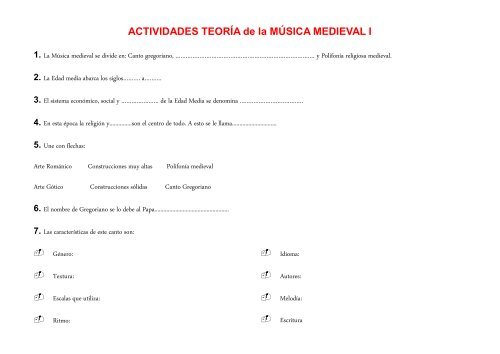ACTIVIDADES TEORÍA de la MÚSICA MEDIEVAL I 1.
ACTIVIDADES TEORÍA de la MÚSICA MEDIEVAL I 1.
ACTIVIDADES TEORÍA de la MÚSICA MEDIEVAL I 1.
You also want an ePaper? Increase the reach of your titles
YUMPU automatically turns print PDFs into web optimized ePapers that Google loves.
<strong>ACTIVIDADES</strong> <strong>TEORÍA</strong> <strong>de</strong> <strong>la</strong> <strong>MÚSICA</strong> <strong>MEDIEVAL</strong> I<br />
<strong>1.</strong> La Música medieval se divi<strong>de</strong> en: Canto gregoriano, ……………………………………………………………………… y Polifonía religiosa medieval.<br />
2. La Edad media abarca los siglos………. a……….<br />
3. El sistema económico, social y …………….…… <strong>de</strong> <strong>la</strong> Edad Media se <strong>de</strong>nomina ……………………………….<br />
4. En esta época <strong>la</strong> religión y...............son el centro <strong>de</strong> todo. A esto se le l<strong>la</strong>ma..............................<br />
5. Une con flechas:<br />
Arte Románico Construcciones muy altas Polifonía medieval<br />
Arte Gótico Construcciones sólidas Canto Gregoriano<br />
6. El nombre <strong>de</strong> Gregoriano se lo <strong>de</strong>be al Papa..................................................<br />
7. Las características <strong>de</strong> este canto son:<br />
Género:<br />
Textura:<br />
Esca<strong>la</strong>s que utiliza:<br />
Ritmo:<br />
Idioma:<br />
Autores:<br />
Melodía:<br />
<br />
Escritura
C<strong>la</strong>sificación según <strong>la</strong> re<strong>la</strong>ción <strong>de</strong>l texto y <strong>la</strong> música:<br />
1 sí<strong>la</strong>ba muchas notas:...........................................................<br />
1 sí<strong>la</strong>ba 1 nota:...........................................................<br />
1 sí<strong>la</strong>ba 2 ó 3 notas:...........................................................<br />
<strong>1.</strong> Las características <strong>de</strong> <strong>la</strong> música <strong>de</strong> trovadores son:<br />
Ritmo:<br />
Textura:<br />
Género:<br />
C<strong>la</strong>sificación según <strong>la</strong>s formas <strong>de</strong> cantarlo:<br />
2 coros se alternan:...........................................................<br />
Solista y coro se alternan:...........................................................<br />
Sin alternancia:...........................................................<br />
<strong>ACTIVIDADES</strong> <strong>TEORÍA</strong> <strong>de</strong> <strong>la</strong> <strong>MÚSICA</strong> <strong>MEDIEVAL</strong> II<br />
Autores:<br />
Esca<strong>la</strong>s que utiliza:<br />
2. Completa:<br />
Los Jug<strong>la</strong>res eran …………………………………… ambu<strong>la</strong>ntes que cantaban historias <strong>de</strong> ……………………… y tocaban muchos ……………………………………….<br />
Los trovadores (…………… Francia) y Los Troveros (………………. Francia) son <strong>de</strong> origen ……………………………. y cantaban canciones <strong>de</strong><br />
……………………… acompañados <strong>de</strong> ………………………………………………………….<br />
3. Las Cantigas <strong>de</strong> Santa María son canciones <strong>de</strong> trovadores pero que hab<strong>la</strong>n <strong>de</strong> <strong>la</strong> …………………………………………. y fueron recopi<strong>la</strong>das por el rey<br />
………………………………………………………<br />
Idioma:
4. Escribe el nombre <strong>de</strong> los instrumentos medievales y c<strong>la</strong>sifícalos en familias y subfamilias:<br />
5. La Polifonía comienza con <strong>la</strong> escue<strong>la</strong> <strong>de</strong> ………………………………………………………. al añadir voces por encima <strong>de</strong>l ……………………………………………………….<br />
Sus autores son ………………………………………………………………………………………………………


